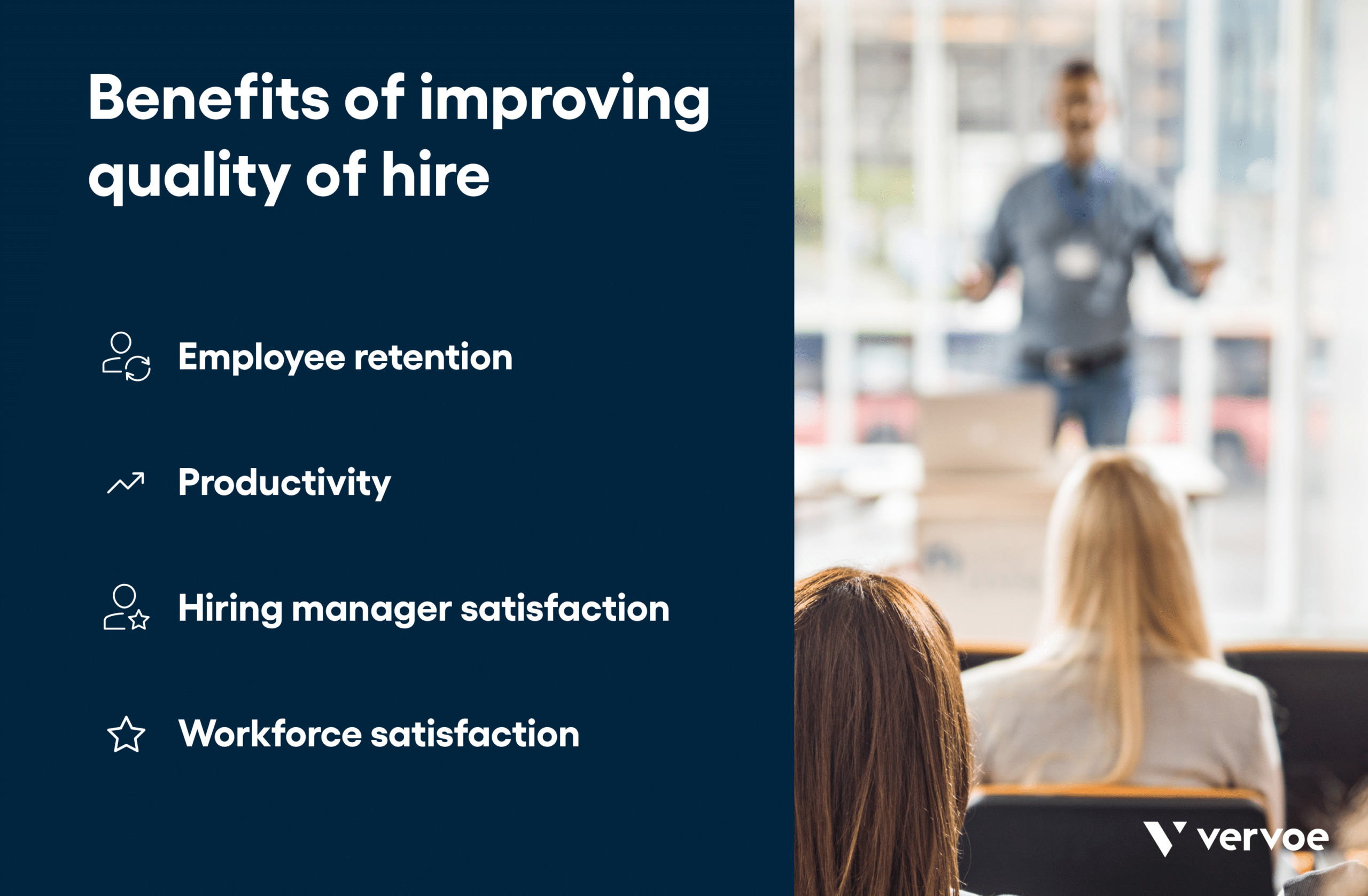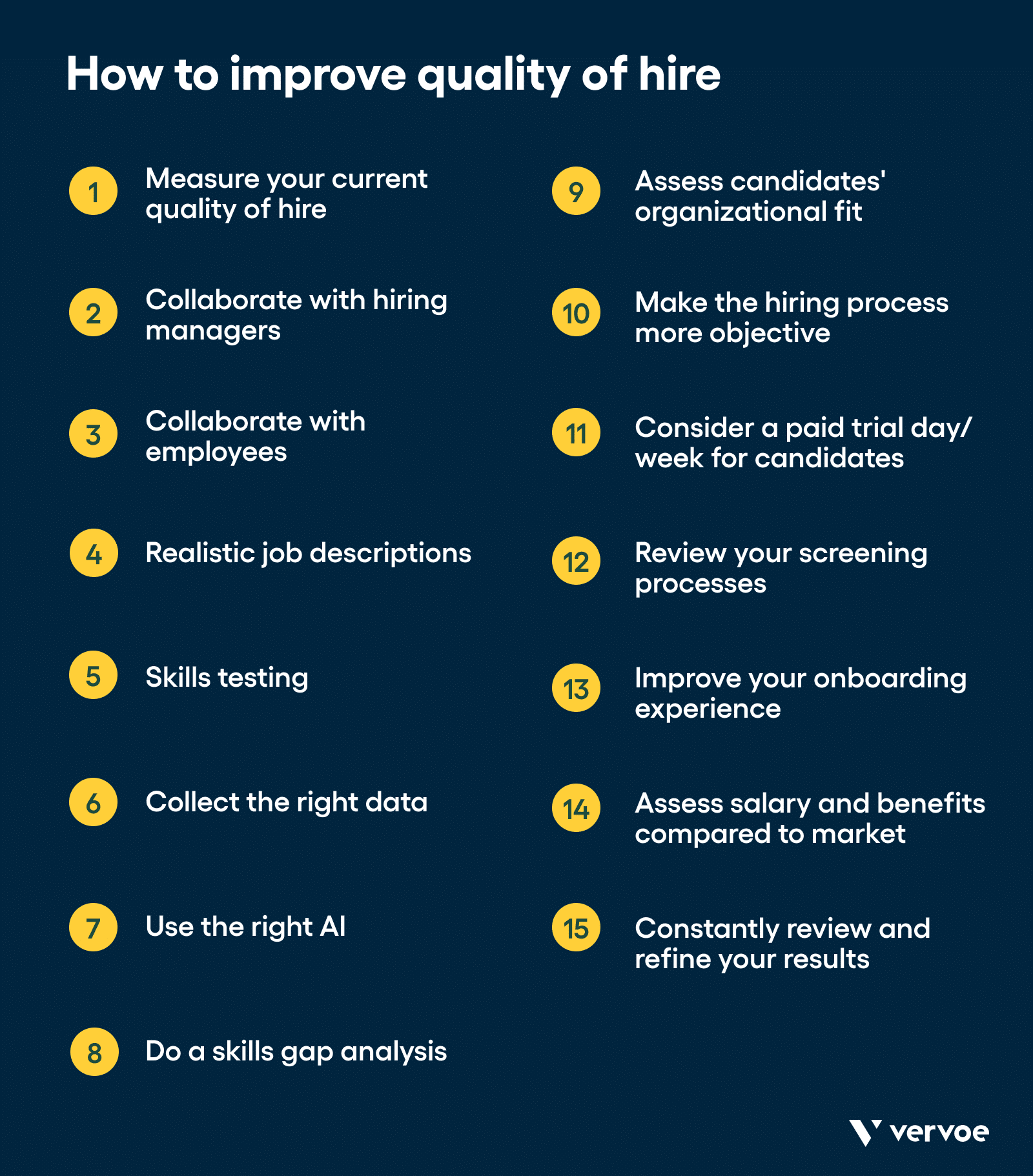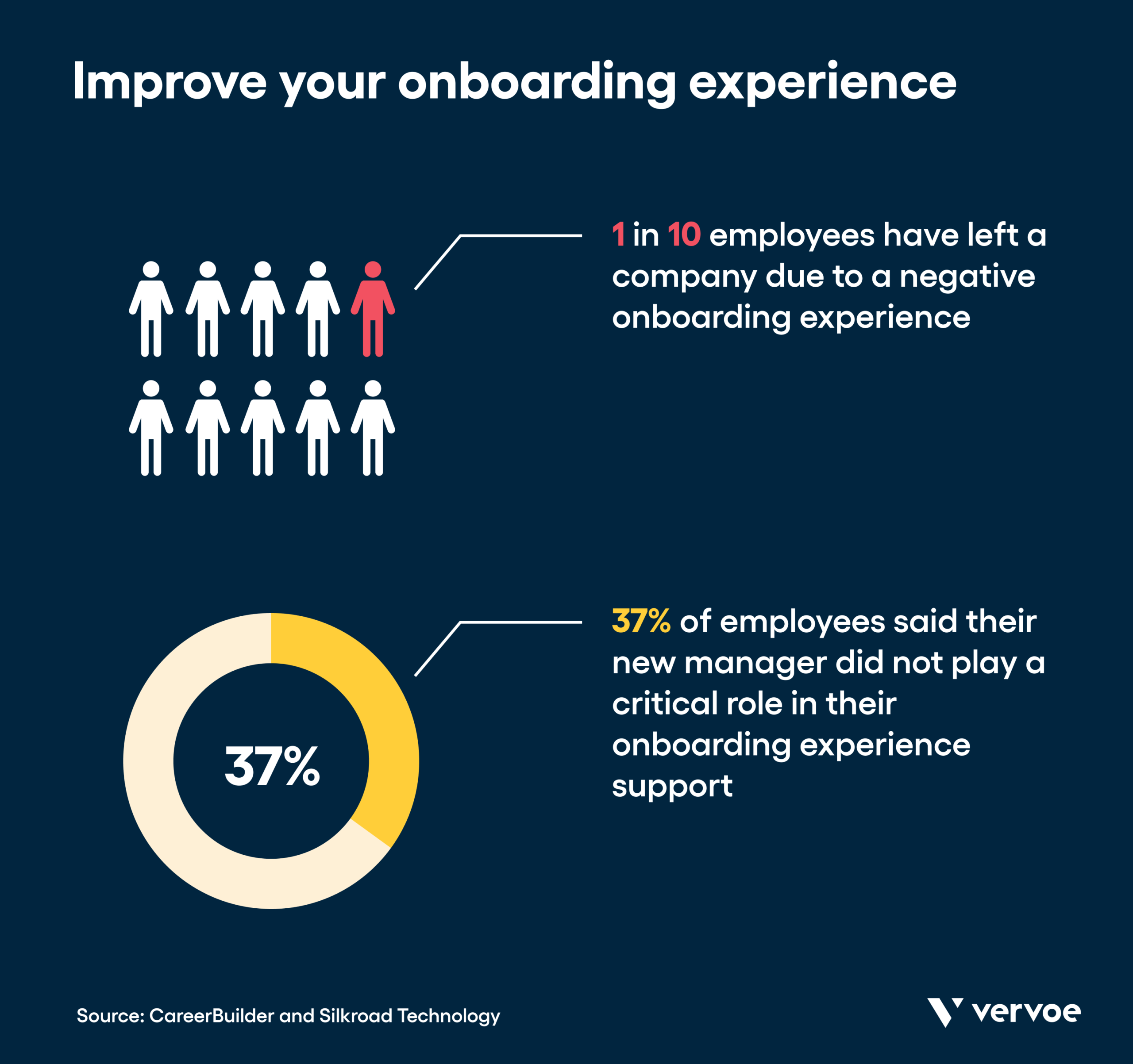Research has shown that high-performing employees can deliver up to 400% more productivity than average. With this in mind, organizations are increasingly focused on improving a key recruitment metric: quality of hire. In this article, we provide 15 actionable tips for doing just that.
What is quality of hire?
Quality of hire is an increasingly popular recruitment metric leveraged by organizations to measure the value of new hires and assess how they are contributing to long-term business success.
The metric is not only used to determine the performance of individual employees but can evaluate the effectiveness of an organization’s overall hiring processes, as well as specific methods or sources of recruitment.
Benefits of improving quality of hire
There are several reasons why improving your quality of hire is good for business:
- Employee retention – when you hire the right person for the right job they are more likely to be happy and motivated, which will ultimately increase employee loyalty and reduce your organization’s turnover rate.
- Productivity – As mentioned, high-performing employees are significantly more productive, helping you to realize your business goals much faster.
- Hiring manager satisfaction – Being lumbered with a bad hire is a frustrating reality for many managers. Spending extra time onboarding, training, and supporting employees who are fundamentally a bad fit is not only demotivating for the individual manager, but it’s costly to the business.
- Workforce satisfaction – A good hire not only benefits your business and the person managing it but the entire workforce. Existing employees will be positively impacted by a new colleague who can quickly adapt to their role and integrate well with their teammates.
How to improve quality of hire
1. Measure your current quality of hire
The first step to improving quality of new hires is to determine what quality hire looks like for your organization and then implement processes to effectively measure it.
Organizations typically consider a range of pre-hire and post-hire metrics such as time-to-hire, ramp-up rate, and retention rate. These factors can be recorded in new-hire scorecards and applied to formulas to calculate the quality of hire for individual employees and specific recruitment methods or sources, as well as the overall quality of hire for your organization.
The insights gained from a formalized quality of hire program will help you to identify any weak spots in your recruitment processes and inform how you refine them moving forward.
2. Collaborate with hiring managers
According to a LinkedIn report on data-driven recruiting, 61% of hiring managers believe recruiters have only a low to moderate understanding of the jobs they’re recruiting for. When it comes to improving your quality of hire, collaboration is absolutely crucial. Hiring managers can help refine job descriptions, screen candidates, and provide guidance on business goals and objectives. By involving them at each stage of the recruitment process, you’ll increase the likelihood of hiring the right person for the right role.
3. Collaborate with employees
Collaborating with employees, alongside hiring managers, during the recruitment process will also improve your quality of hire. You might choose to directly involve your employees, via a multi-stage interview process or a panel interview, or simply invite them to give feedback on candidate profiles. In doing so, you‘ll relieve the pressure on the recruiter to find the perfect candidate, increase your chances of finding someone who’ll assimilate naturally into your workplace, reduce time-to-hire, and limit instances of unconscious bias.
Candidates will value the opportunity to meet with current employees to ask questions and learn more about your organization, which will ultimately improve the overall candidate experience and increase your chances of securing top talent.
4. Realistic job descriptions
No new employee wants to start a role only to realize that they’ve been misled by an inaccurate or misleading job description.
Failure to write a realistic job description not only results in unhappy and demotivated employees, which can increase your turnover rate, but it also means you’re more likely to hire someone unsuitable, or even under-qualified, for the job.
5. Skills testing
Skills testing is designed to measure and assess candidates’ skills, abilities, and behavioral profiles to determine their suitability for a role and the likelihood they will integrate well within a workforce. A report from the Talent Board’s Candidate Experience found that 82% of companies use some form of skills testing to screen job applicants.
Skill testing can drive efficiencies and reduce costs within the recruitment process by quickly reducing an organization’s talent pool and identifying the most suitable and promising candidates. In addition, assessments also enable hiring organizations to better distinguish between similar candidates and reduce instances of unconscious bias.
6. Collect the right data
If you’re not being methodical and comprehensive with your data collection, it will be difficult to accurately assess your current quality of hire and make meaningful changes.
Compile a list of important pre-hire metrics (such as time-to-hire and cost-to-hire) and post-hire metrics (such as ramp-up time, retention rate, and hiring manager satisfaction) and consider how best to collect and store data for them.
For qualitative metrics, in particular, you’ll need to think carefully about how to measure success. Employee engagement surveys, performance reviews, and hiring manager satisfaction surveys might be useful here.
Consider investing in a tech solution to make the process of data collection and analysis simple, efficient, and effective. Some tools can track employee performance, automate assessments, and consolidate different types of data to provide actionable insights.
7. Use the right AI
Artificial Intelligence (AI) can be applied in numerous ways throughout the recruitment process to improve your quality of hire.
Machine learning (ML) software, for example, can be applied to analyze historical resumes, interviews, and assessments to draw conclusions about prospective candidates and inform your decision-making.
AI can help you to develop accurate job descriptions, target suitable candidates online via “programmatic job advertising”, automate elements of the recruitment and onboarding process, reduce unconscious bias, assess the effectiveness of specific recruitment methods or sources, and improve the candidate experience.
8. Do a skills gap analysis
Almost 80% of Americans believe there’s a skills gap, and so it should come as no surprise that Deloitte predicts this could have a $2.5 trillion impact on the US economy within the next decade.
Unfilled positions, due to an organization’s struggle to find suitable talent, can cost businesses upwards of $800,000 per year, which is why it’s so important to address the skills gap.
Skills gap analyses are designed to help you identify what gaps exist between your workforce’s current skill sets and the skills you need to realize your long-term objectives. You’ll need to determine your future goals, measure your existing workforce, and make a plan to upskill or retrain your current employees or seek out new talent with your desired capabilities.
9. Assess candidates’ organizational fit
Organizational fit describes the circumstance when an employee’s professional and personal values align well with their employers.
By assessing candidates for organizational fit, you increase the chances of recruiting someone who will go on to be a happy, productive, motivated, and loyal employee.
Organizational fit can be assessed via situational judgment tests, a trial period in the workplace, robust reference checking, collaborative hiring, and in-person assessment days.
Importantly, hiring people for cultural or organizational fit doesn’t mean building a homogenous workforce. It’s more about finding candidates who share your core values, will be proud to work for you and will be driven to help you realize your long-term business goals.
10. Make the hiring process more objective
Traditional recruitment methods are often highly subjective. Unstructured interviews, inconsistent processes, rigid pre-screening methods, and biased hiring managers can all result in bad hires and talent with enormous potential being overlooked or unfairly ruled out.
There are many ways to make your recruitment process more objective. This might include clearly defining job requirements, conducting structured interviews, implementing collaborative hiring, and using skills assessments. Consider whether your existing interview and assessment format might be isolating or alienating certain candidates or failing to identify the most appropriately qualified.
11. Consider a paid trial day/week for candidates
Paid work trials provide an opportunity for you to get to know your shortlisted job candidates a little better, see how they respond to everyday pressures and challenges in your workplace, and how they interact with the rest of your team.
It’s also a chance for prospective employees to assess you by learning more about the workplace and getting to know some of their would-be colleagues.
Those who enjoy their experience and perform well are more likely to accept a job offer and go on to be high-quality employees, which will reduce your time-to-hire and improve retention rates.
12. Review your screening processes
Pre-screening tools often prove themselves to be invaluable when it comes to quickly reducing a large talent pool and driving efficiencies within the recruitment process.
Nonetheless, you need to be careful to ensure your screening criteria are accurate, fair, and consistently reviewed and refined.
13. Improve your onboarding experience
A clunky, disorganized, and laborious onboarding process gives a bad first impression to new hires and can negatively impact your organization’s retention rate.
A study by CareerBuilder and Silkroad Technology found that one in 10 employees have left a company due to a negative onboarding experience, while 37% of employees said their new manager did not play a critical role in their onboarding experience support.
A good onboarding experience not only makes employees feel welcome but also enables them to quickly acclimatize to their role and integrate with new team members. As a result, they’ll get up to speed far more quickly and be motivated to deliver good results.
To improve your onboarding process, consider which elements can be automated to drive efficiencies, try to provide a personal and warm experience for your new hires, and provide all the resources and support they need to quickly settle into their new role.
14. Assess salary and benefits compared to market
This one could almost go without saying. If you’re not willing to pay your employees a competitive salary and offer an attractive benefits package, you simply won’t attract or retain top talent.
Make sure you investigate market rates each time you list a new job opening. If you’re unable to compete with the biggest industry players, consider what other incentives you could offer new hires or, better still, ask them what benefits they would appreciate. This might include flexible working or additional annual leave.
15. Constantly review and refine your results
Improving your organization’s quality of hire is an ongoing and long-term process. You’ll need to continually evaluate your data to determine what’s working and what’s not and be prepared to pivot your strategy based on current recruitment trends and your business’ evolving objectives and priorities.
Final thoughts
In most cases, improving hiring metrics is about optimizing your recruitment funnel efficiency. But improving quality of hire can be linked directly to driving business performance. Prioritizing this high-impact metric is a sure-fire way to boost retention, productivity, satisfaction, and exceed your organizational targets by hiring great people.























